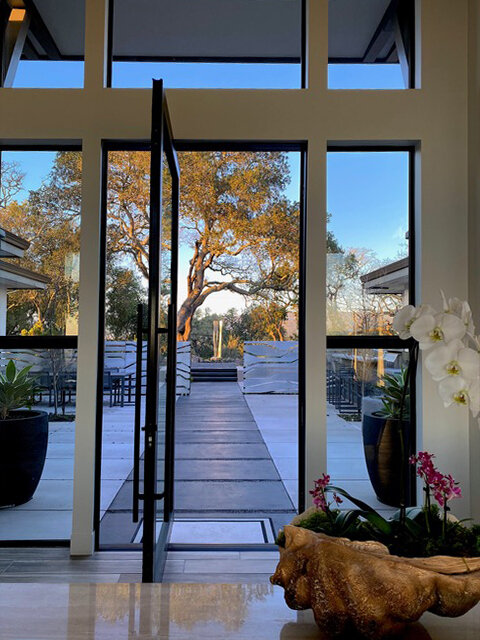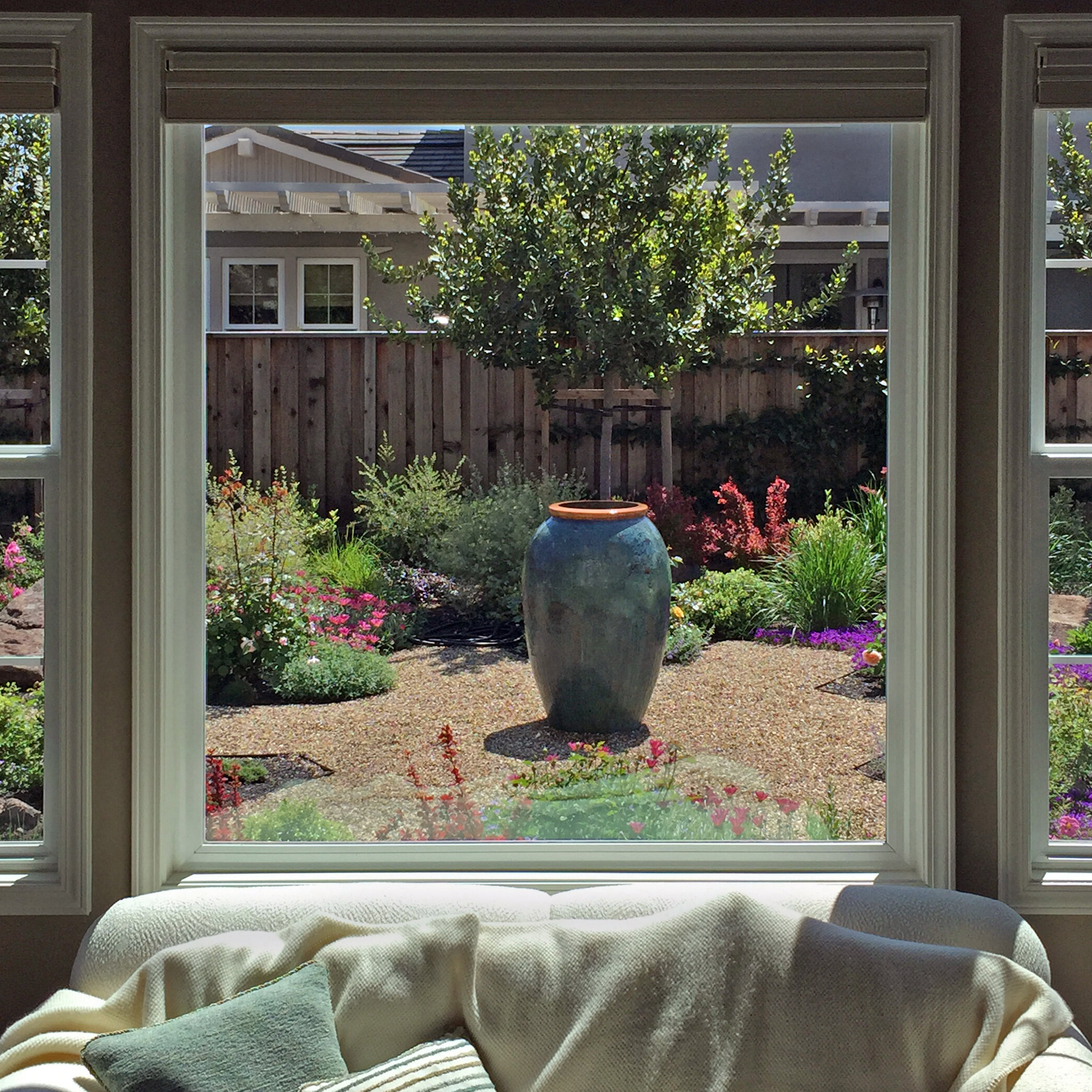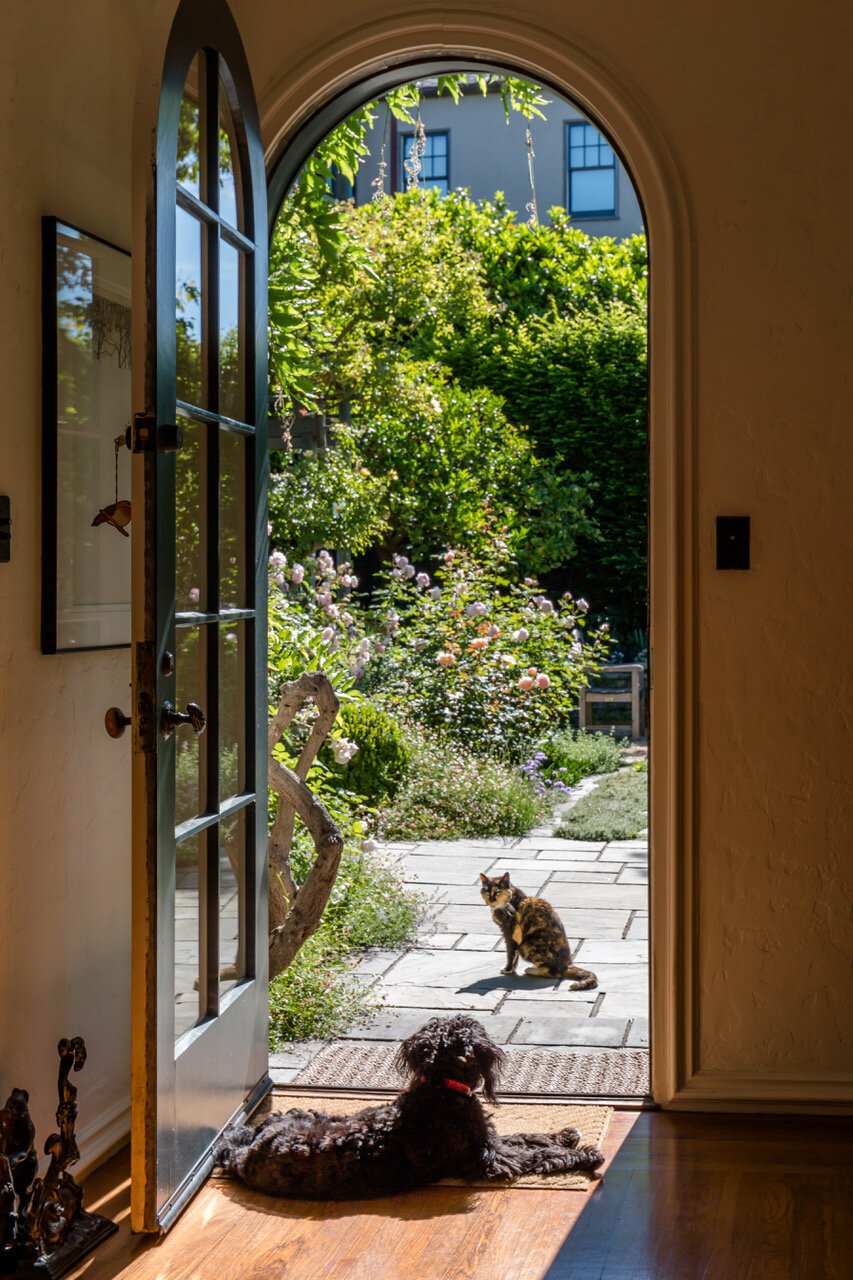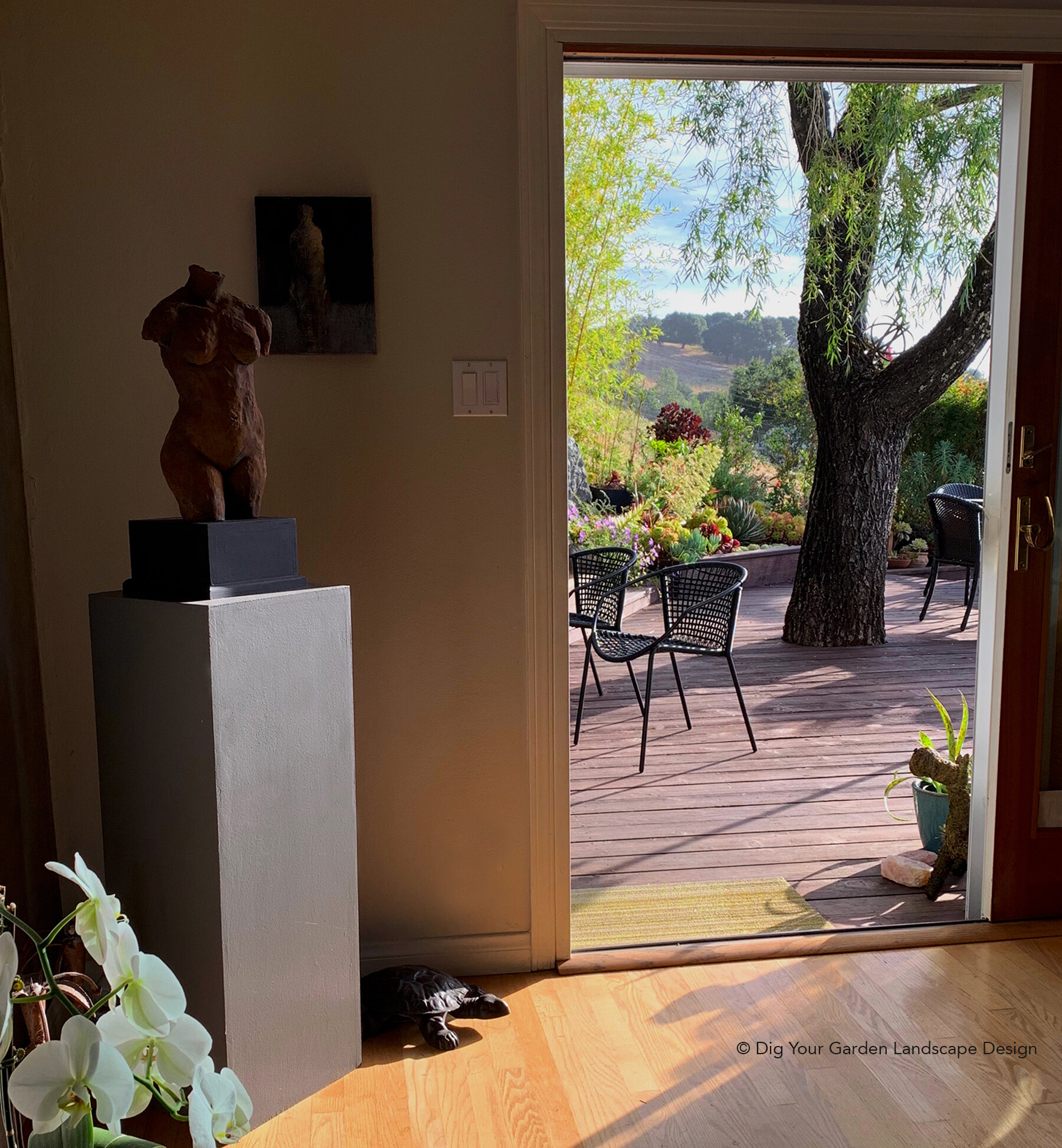Photo courtesy of Lisa Parramore.
Outside My Window
by Lorri Hart
Clear The Way Landscape Design Napa, CA
I’m staring out the window on a dark winter night in Minnesota. It’s snowing heavily. Suddenly, the headlights of my dad’s car turn into the driveway and mom turns on the porch light. The illumination makes the snow come alive! Before the lights, it was a monochromatic picture. Once the crystalline flakes were lit against the black night, what had been mundane became thrilling to watch.
What made the snow more exciting when the lights came on? It became luminous because of the extreme contrast between the black sky and white snowflakes.
As a child, I stared through windows all the time, longing to be outside. I was fascinated by the weather, the clouds, and the movement of the trees in the wind. Observing nature through the window was my next best choice when I couldn’t play outdoors.
This familiar vantage point has served me well as a landscape designer. I like to start every design inside the house, looking through the windows and doors to understand how clients will experience their garden through the framed views from each room. It’s an inside-out approach.
Photo courtesy of Lorri Hart
A current project brought this concept home to me. The home and entire landscape had burned to ash in the 2017 Atlas fire in Napa, so we were starting with a blank slate. The only surviving tree was just beyond the back property line, a nice redwood. Months into the project, the new construction had reached a point where I was able to step inside and walk around on the elevated main floor. This was my first view of what the clients would see from each window and door.
To my surprise, I realized the lone redwood tree was directly centered in the view entering the front doors all the way out to the back picture windows! I was excited by how my design focus had just shifted. From this vantage point I was able to see something that was not perceptible when I was outside at ground level, walking around the house.
It’s important to think about how a design will look from different indoor and outdoor perspectives, but also at different times of the day. Most of us only visit our clients’ homes during daylight hours, so that is where we draw our inspiration from. But a design should delight at all hours! Imagine how your designs will look at night, from inside the house. Will it thrill your client like the lit-up falling snow? Will it provide calm and serenity when they lay down to rest?
When designing for nighttime, lighting and contrast are important tools for making your designs stand out. Imagine a romantic moonlit garden. White, pale pink, and light yellow flowers shine, and silvery foliage glows (think Correa ‘Ivory Bells’), while the reflective surface of water in a birdbath glimmers. Light-colored foliage and high-contrast designs are important components of a moon garden, which allows us to enjoy a landscape well into the night hours.
Gorgeous effects, from subtle to exuberant, can also be created with landscape lighting. I remember staring out my hotel room window in Hawaii at night, at the brightly-lit breaking waves on the beach. It was dramatic. Hotels often shine floodlights at the surf to accentuate this phenomenon of nature in continuous motion.




Perhaps there is an opportunity for you to create a calming or dramatic effect by lighting some element of the garden that will show movement, like fluttering leaves in the tree outside the bedroom window. It’s not always apparent, but during the design process it may be worth thinking about what they will see when laying on a couch or in bed at night.
Biophilic design is an emerging science that has proven the value of connecting to nature for our health, well-being and productivity. As more people work from home, think about how necessary it is for them to take a break from their computer screen every so often to stare out the window. By providing a visual respite for our clients with a well-framed garden view we can increase their productivity and ultimately their sense of well-being.
The movement of birds, bees, and butterflies can make an environment come alive. Encourage this by planting nectar-producing plants such as Salvia ‘Amistad’ and providing water to attract them, particularly near the windows people use most often. Many studies have shown that watching birds out the window can improve our mental state and cognitive functioning. It’s gratifying to think we, as designers, are improving not just the environment, but the health and well-being of our clients.
Try designing your next project from the inside out by spending time with the client inside their home, and at different times of day. It may increase your understanding of their needs as you sit in their desk chair, stand at their kitchen sink, or even observe what they will view from their own bed!
Give your clients the benefit of your ‘designer’s eyes’ by sharing their indoor experiences of the world outside their window. It may just be as important as the time you spend with them walking the garden as you are creating their new landscape.
Inside the Garden Orchestra
by Bianca Vallorz
Golden State Gardens San Jose, CA
Ceanothus and Muhlenbergia rigens are used to add interest in the garden by contrasting forms, textures, and colors.
A beautifully executed landscape design is an orchestra, and we, the landscape designers, are the conductors. Our pen is the baton, the tracing paper is the sheet music to compose our ideas, and the plants are the notes. Much like the different members of an orchestra, each plant plays a specific role to help it shine as a specimen, provide structure as a background shrub, or add contrast in form, color, or texture. Whether the plant’s purpose is to elicit excitement, create a private screen, or provide a food source for local pollinators, each element has a purpose, a reason for its inclusion in the orchestra. An incorrectly placed element can throw off the entire balance and shatter the harmony.
Both of the clients’ San Diego, CA and Atlanta, GA backgrounds are built into this earth friendly landscape design.
I often come across people who do not understand how each element contributes to the harmony of a design—they assume that designers simply select a few plants to place anywhere. However, every design is special and unique, catered to the individual client’s needs, desires, likes, and dislikes.
Upon first meeting the clients, I listen to their story, asking them where they grew up and their favorite season. Some question the importance of their childhood city to the design, but it is my belief that knowledge of these minute details helps me create a more intimate landscape. For example, I had two clients who requested a California native landscape. After finding out that one owner was from Atlanta, Georgia and loved large established trees, while the other was from San Diego and loved native wildflowers, I was able to compose one cohesive landscape encompassing both of their landscape interests. The landscape includes an open wildflower meadow in one space, and a patio with a southern plant palette in another space, while large trees are used to create balance and frame the property. Understanding your clients is the first, and most critical, step to creating something they will love for years to come.
Helictotrichon sempervirens adds color and texture contrast, excitement, and frames the Ceanothus maritimus ‘Valley Violet.’
Following the initial meeting, I perform a site analysis, examining the sun location, drainage and grading issues, privacy, limitations, and opportunities. Examining the entire residence and property is a crucial step in my design process and serves as a basic component for creating a base plan.
A hummingbird enjoying an evening sip of nectar from the bright red Epilobium canum.
Photos courtesy of Bianca Vallorz.
After the construction of a base plan, the real creative expression starts to emerge. Taking a few moments to look through the site photographs and analysis, I quickly jot down potential locations for key elements. Perhaps the ideal place for a private hot tub is located along the west fence overlooking the east foothills in order to romanticize the slow-setting summer sun? Or perhaps the “secret garden” can be tucked under the large existing redwood tree, thereby creating a private space from the neighbors’ house on a hill? Or perhaps the broad deciduous tree is used to balance the landscape with the protruding driveway?
Once the elements are properly placed, hardscape and planting beds are formed. Again, listening to the clients is the best tool for identifying their style preference. If the clients have modern tastes they may prefer harder edges and clearly defined lines, or if they are “woodsy” types they may prefer softer forms.
Next comes plant selection. An immense amount of decision and weight goes into identifying the right balance of contrasting elements, while still creating a cohesive design—deciduous vs. evergreen, tall vs. short, fragrant vs. non-fragrant, sharp edges vs. soft edges, green leaves vs. gray leaves, or purple flowers vs. yellow flowers. Too much of one element will skew the beautiful melody the plants are playing, making them appear “out of tune” with one another.
Each step along my design process is vital in creating a stunning landscape design. However, it is in the final step of plant selection that the design comes to life and sings with excitement. It comes to life in the blue-green Helictotrichon waving to you in the breeze. It comes to life in the Cercis tree whose heart shaped leaves change from lime green to golden yellow as she prepares for winter hibernation. It comes to life in the Epilobium’s firecracker red flowers enticing her friend, the hummingbird, to drink her sweet nectar. The garden orchestra is playing beautifully for all to hear—all we have to do is listen.
Flooring to Bring the Indoors Out
by Lisa Parramore, APLD
Harrell Remodeling
Palo Alto, CA
Photo courtesy of Kebony.
Bringing the indoors out is an emerging trend in the field of landscape design and outdoor living. The demand for an outdoor space as inviting and comfortable as its indoor counterpart is driving new products and materials that allow designers to meet our clients’ increasingly sophisticated needs. In particular, the flooring we choose can define the look, feel, and function of our outdoor rooms.
How many of us have talked to clients who want to step outside onto a deck or patio without stepping down? A deck can usually serve this purpose quite well, but what about tile, stone, or pavers? Clients are sometimes surprised to learn what is required to continue the look of stone or tile at the same level as the interior. It may require flashing to separate the exterior wall from the new raised patio, or the designer may have to re-locate electrical outlets, vents, downspouts, or hose bibs. A step (or steps) down to grade will be necessary at some point, but this can be an opportunity to direct how people move throughout the back yard. A railing, built-in bench or planters along part of the perimeter can make the space feel cozy, and the openings can direct circulation patterns to other focal points in the yard. Such elements can also help alleviate the effects of any uneven grade.
Photo courtesy of Lisa Parramore, APLD.
Continuity of materials is another area that designers may consider. If the adjacent interior room has hardwood floors, a decking material that complements the direction, color, grain, and plank size can make the spaces look and feel cohesive. The sheer number of decking materials available now can be overwhelming, but specialty decking stores are an excellent resource to learn about them and obtain samples. Concerns about how redwood and ipe (also called ironwood) are harvested have spawned innovations in composite wood choices, and more recently, “modified wood.”
Composite woods and their cousin, PVC, have improved in quality so much that 25 or 30-year warranties are now commonplace. While most of them cannot mimic the look of natural wood, the variety of colors and patterns allow the designer to select almost any shade—from red, brown, and gray undertones. My favorite is Zuri, which has a realistic wood grain superior to its competitors.
The emergence of modified wood products such as Kebony and Accoya present additional opportunities to design sustainably. They offer durability and a similar patina to natural hardwoods. Bamboo decking, certainly a contender for sustainability, had an uneven entrance into the market a generation ago, but companies such as Moso now offer a product that comes with a 20-year warranty.
Photo courtesy of Belgard.
If the interior floor is tile, expanded options to match or complement await us! Natural stone such as slate still works as an excellent choice both inside and out (except for shower floors due to the inevitable calcium deposits). One exciting trend is the array of outdoor porcelain products on the market. The trend is happening at both ends of the market: paver companies such as Belgard now offer porcelain pavers and tile companies such as Arterra now manufacture outdoor porcelain pavers in the same designs as their indoor counterparts. Many of these pavers are just two centimeters thick and of course need to be installed over a concrete slab if the finished height is to be even with the home’s interior, but they are also strong enough to be installed over base rock and sand at grade, just like traditional concrete pavers. Plank-like sizes with wood-grain designs continue the look of an interior wood floor, while large format porcelain pavers boast lovely muted and mottled patterns and textures that are well-suited to contemporary architecture. Porcelain pavers do not stain and the larger format pavers reduce installation time; coping paver options can be used at step edges.
Take a closer look at these different flooring materials, and keep them in mind as distinctive ways to bring the indoors out in your next project!
Inside Out Plants
by Shireen Zia
EarthCare Landscaping
San Jose, CA
Whether you are designing a landscape for new construction or sprucing up a mature garden, a few plants always come to mind which you know can never disappoint no matter which palette you use them in. As designers we search for plants that will not only bring life to our designs and an inviting outdoor living experience to our clients, but also serve a larger purpose to help amend the soil and support a healthy ecosystem. I am sure you have already pictured a few of your favorite plants; but are they as beneficial inside the soil as they are above ground?
Allow me to present three versatile plants that can be part of any landscape, to help nourish the soil and sustain the local ecology. Which one will become your go-to “inside out” plant?
Photo courtesy of Emerisa Gardens.
Achillea millefolium (Yarrow)
Inside:
Soil Amendment: Achillea helps to improve the soil biology. Its deep roots accumulate potassium, phosphorus, and copper from the subsoil and distribute them as fertilizer to the surrounding soil.
Erosion Control: Due to its high drought tolerance and deep root systems, Achillea can be an excellent ground cover for erosion control.
Fertilizer: Yarrow roots also secrete substances that attract nitrogen-fixing bacteria; whether planted in the garden or composted, yarrow will encourage soil microbes that improve garden productivity and overall health while reducing the need for chemical fertilizers.
Permaculture: Yarrow can be used as a living mulch in dry areas. It is commonly used under fruit trees as a cover crop to help fertilize and enhance fruit production.
Outside:
Pest Management: Yarrow flowers help to wards off pests in the landscape by attracting beneficial insects like lacewings, parasitoid wasps, ground beetles, ladybugs, and hoverflies. The oil of Achillea leaves can even be used as a mosquito repellent.
Rain or Shine: Achillea is extremely resilient and grows well with little water during the hot summer months, yet it also thrives in rain gardens.
Herbal Properties: Yarrow can be used as an astringent to treat minor cuts and scrapes. It’s also used as an ingredient in tea, soups, beers, and other alcoholic beverages.
Long Blooming Season: Yarrow can bloom from late spring through the early fall.
Pollinators: Achillea flowers are a favorite of butterflies and bees, and its leaves feed caterpillars of all kinds.
Compost Starter: Yarrow is an excellent compost starter plant, or simply use it as a “chop and drop” mulch to build soil.
Photo courtesy of Emerisa Gardens.
Echinacea species
(Perennial Coneflowers)
Inside:
Immunity Booster: Echinacea is said to provide many health benefits, notably reducing inflammation and bolstering the body’s immune system to fight infections, especially the common cold and flu. Echinacea purpurea is the most versatile coneflower variety since the whole plant can be used; only the root and rhizome of Echinacea angustifolia and Echinacea pallida are considered beneficial.
Antioxidant Effects: Coneflower roots, leaves, and flowers are rich sources of flavonoids and alkamides that can help to protect the body against the long-term damage caused by oxidation.
Pet Friendly: The benefits of Echinacea may extend to pets such as dogs and even chickens, helping them recover from viral and parasitic infections.
Outside:
Improves Mood: The sweet fragrance of Echinacea can help to decrease feelings of sadness and stress.
Versatile: Plant breeders have developed a wide variety of colors to suit any garden palette, from the traditional purple to shades of pink, white, yellow, and orange.
Durable: Echinacea thrive in full or part sun and tolerate afternoon heat and clay soil. They are reasonably drought tolerant once established and semi-deciduous in some areas.
Long Blooming Season: Coneflowers bloom from spring through fall, and the seed heads provide structure and interest in the winter garden as well.
Habitat Plant: Echinacea species are great in rain gardens, and their flowers sustain pollinators and parasitic wasps. When the spent flower heads are left on the plant, their seeds nourish goldfinches and other songbirds.
Photo courtesy of Wikimedia Commons.
Symphytum officinale
(Common Comfrey)
Inside:
Soil Amendment: Comfrey is a “dynamic accumulator” that pulls in a lot of nutrients from its tuberous roots. When the foliage is cut and left as mulch, it revitalizes the shallower soil layers with minerals such as calcium and magnesium that would otherwise be hard to access.
Compost Tea: Symphytum is high in just about every nutrient a plant needs, including the big three — nitrogen, phosphorus, and potassium — as well as many trace elements, making it an excellent base for home-brewed compost tea.
Clay Buster: The large, thick taproots of Comfrey may grow six feet deep or more, making it useful for breaking up heavy clay soil.
Permaculture: Comfrey’s nutrient profile makes it one of the must-have plants for a permaculture garden, especially beneficial to fruit trees. Comfrey can be used as “green manure,” as an alternative or supplement to animal manures as a soil amendment.
Outside:
Healing Herb: Symphytum has been cultivated since about 400 B.C. as a healing herb. Commonly known as Knitbone, it contains allantoin, which promotes cell growth, and is traditionally used topically to treat cuts, rashes, bruises, and sprains. (However, comfrey is considered unsafe for consumption because it contains toxic alkaloids.)
Chop and Drop: Comfrey can easily be used to add nutrients to the soil by chopping up the leaves and dropping them around the base of fruit trees or heavy-feeder plants.
Top Dressing: Powdered comfrey leaves can be used as fertilizer in late winter or early spring before the garden has begun producing new foliage. The powder decomposes more readily than fresh leaves, which is advantageous for the spring garden.
Background Plant: Even if you are using Symphytum mainly to provide support to the ecosystem of the yard, its bold, bright green foliage makes a beautiful background filler.
Pollinators: The bell-shaped pink, purple, or cream-colored flowers attract native bees, butterflies, and hummingbirds from late spring into autumn.
The next time you’re developing a plant palette, consider the many virtues these specimens possess and look into the benefits that other plants can provide both inside and out!




